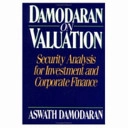

Damodaran on Valuation: Security Analysis for Investment and Corporate FinaUpplaga 1
- Upplaga: 1a upplagan
- Utgiven: 1994
- ISBN: 9780471014508
- Sidor: 464 st
- Förlag: John Wiley & Sons
- Format: Bok
- Språk: Engelska
Om boken
Åtkomstkoder och digitalt tilläggsmaterial garanteras inte med begagnade böcker
Mer om Damodaran on Valuation: Security Analysis for Investment and Corporate Fina (1994)
I maj 1994 släpptes boken Damodaran on Valuation: Security Analysis for Investment and Corporate Fina skriven av Aswath Damodaran. Det är den 1a upplagan av kursboken. Den är skriven på engelska och består av 464 sidor. Förlaget bakom boken är John Wiley & Sons som har sitt säte i Hoboken.
Köp boken Damodaran on Valuation: Security Analysis for Investment and Corporate Fina på Studentapan och spara pengar.
Referera till Damodaran on Valuation: Security Analysis for Investment and Corporate Fina (Upplaga 1)
Harvard
Oxford
APA
Vancouver



















